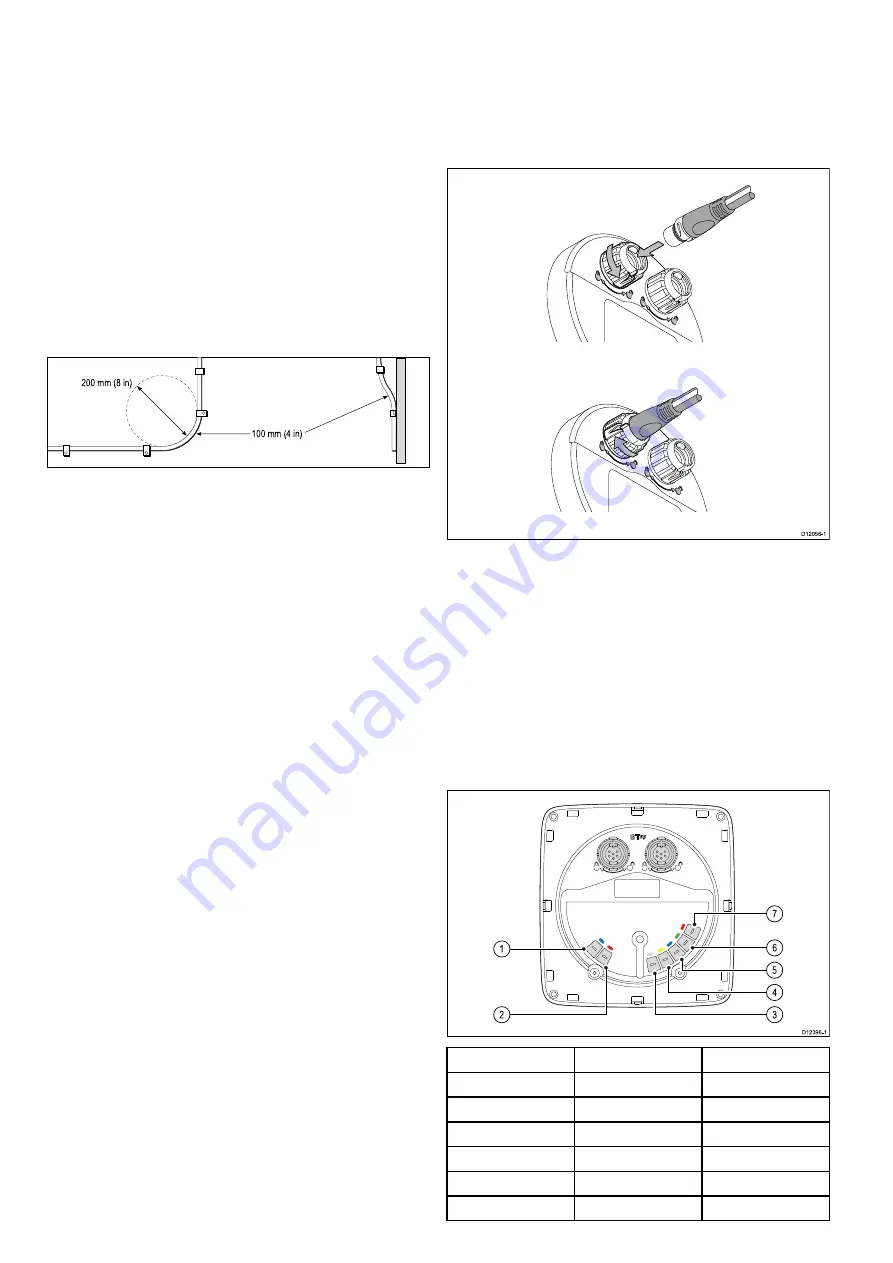
4.1 General cabling guidance
Cable types and length
It is important to use cables of the appropriate type and length
• Unless otherwise stated use only standard cables of the
correct type, supplied by Raymarine.
• Ensure that any non-Raymarine cables are of the correct
quality and gauge. For example, longer power cable runs may
require larger wire gauges to minimize voltage drop along the
run.
Routing cables
Cables must be routed correctly, to maximize performance and
prolong cable life.
• Do NOT bend cables excessively. Wherever possible, ensure
a minimum bend diameter of 200 mm (8 in) / minimum bend
radius of 100 mm (4 in).
100 mm (4 in)
200 mm (8 in)
• Protect all cables from physical damage and exposure to heat.
Use trunking or conduit where possible. Do NOT run cables
through bilges or doorways, or close to moving or hot objects.
• Secure cables in place using tie-wraps or lacing twine. Coil
any extra cable and tie it out of the way.
• Where a cable passes through an exposed bulkhead or
deckhead, use a suitable watertight feed-through.
• Do NOT run cables near to engines or fluorescent lights.
Always route data cables as far away as possible from:
• other equipment and cables,
• high current carrying ac and dc power lines,
• antennae.
Strain relief
Ensure adequate strain relief is provided. Protect connectors
from strain and ensure they will not pull out under extreme sea
conditions.
Cable shielding
Ensure that all data cables are properly shielded that the
cable shielding is intact (e.g. hasn’t been scraped off by being
squeezed through a tight area).
4.2 Connections overview
Connections are made using the provided SeaTalk
ng
and
transducer cable connectors on the rear of the unit.
SeaTalk
ng
connections
The unit has 2 x SeaTalk
ng
connectors on the rear for connecting
to a SeaTalk
ng
network.
D12056-1
Connecting SeaTalk
ng
cables
1. Rotate the locking collar on the back of the unit to the
UNLOCKED position.
2. Ensure the spur cable end connector is correctly oriented.
3. Fully insert the cable connector.
4. Rotate locking collar clockwise (2 clicks) until it snaps into
the LOCKED position.
Transducer connections
Transducer connections only apply to the i60 Wind instrument,
the i60 Close hauled wind does not include transducer
connections as it is a repeater display.
i60 transducer connections
6
7
3
4
5
D12396-1
1
2
1
Blue
Rotor + (Rotavecta)
2
Red
Rotor – (Rotavecta)
3
Grey
Wind 0 V (Shield)
4
Yellow
Anemometer (signal)
5
Blue
Cosine wind direction
6
Green
Sine wind direction
7
Red
Wind V+
20
i60
Summary of Contents for E70061
Page 2: ......
Page 4: ......
Page 6: ...6 i60...
Page 18: ...18 i60...
Page 24: ...24 i60...
Page 34: ...34 i60...
Page 38: ...38 i60...
Page 39: ...Chapter 8 Using alarms Chapter contents 8 1 Alarms on page 40 Using alarms 39...
Page 58: ...13 4 Converters Part number Description E22158 SeaTalk to SeaTalkng Converter 58 i60...
Page 60: ...60 i60...
Page 61: ......
Page 62: ...www raymarine com...
















































